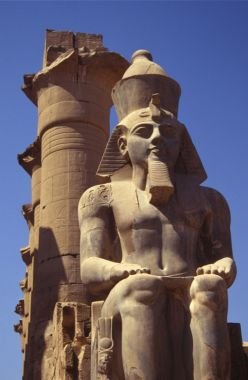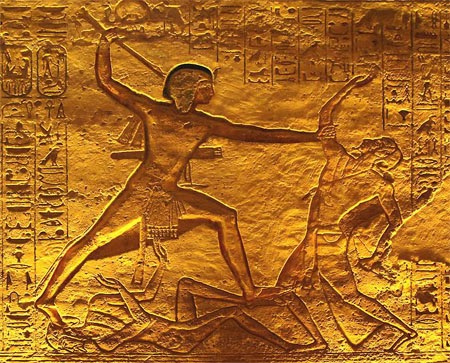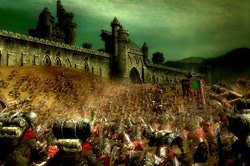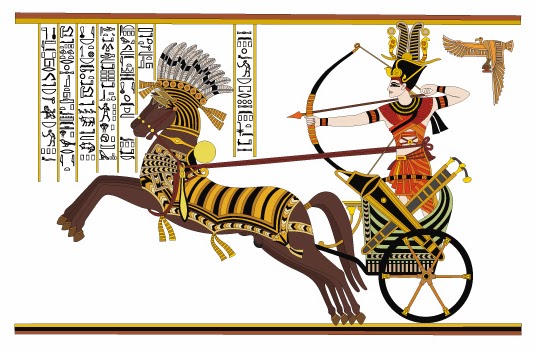Battle of Cadiz
Battle of Cadiz
This battle took place between the forces of King Ramses II of Egypt and the Hittites under the leadership of King Mawatley II in the city of Kadesh, located on
The western side of the Asi River south of Lake Homs is several kilometers away, and this battle is dated to the fifth year of the reign of the king
Ramses II (the fifth year of the month of Shamu, the ninth day), about 1274 BC
The battle is the most famous battle fought by King Ramses II in his struggle with the Hittites.

Ramses II
Who are the Hittites?
The Hittites are an ancient people in Asia Minor and northern Syria, due to the tribe of the Anatolian tribes known as Khatti ..
And they called their country in the days of the Second Kingdom as a country of sinners or Hati or Khatti and included their kingdom Anatolia and a large part of the northwest Crescent Fertile. The ancient Hittites merged with the Indian-European people and flourished (2000-1200 BC) and established a strong state with its capital, Hatosha, in the place of Bogar, Kui-present-Bugazkoy (144 km from Ankara), where excavations revealed the largest collection of documents, The history of their state, consisting of more than 10,000 pottery plates collected by their kings (circa 1300 BC), is written in mussamaria, some of them written in hieroglyphics and showing their artistic talents in their inscriptions and seals, as well as the Babylonian and Assyrian influence.
From the Babylonian, Assyrian, and Egyptian sources, some important facts about the history of the Hittites were known. Around 1800 BC, the Hittites ruled an empire whose status was Kabdokite. Their king, Marshal I, was able to pillage the city of Babel, overcoming the Hamorabi family and 1400 BC. In Asia and in 1290 BC, the Hittites clashed in battles with the Hurri-Mitani, which led to the fall of the Mitani and the survival of the Hittites and the Egyptians in the arena of the conflict followed by a clash between the Hittites and the Egyptians, led by Ramses II at Kadesh, Ramses II married Princess eminence afterwards.
The empire fell after the wave of sea people that crawled towards the region in the late 12th century BC. Then it was built on the ruins of small kingdoms of its centers Karknish, Aleppo and Hama.

The decline of Egyptian influence in Western Asia in the era of the late kings of the 18th Dynasty began as a direct result of the unrest caused by the Akhenaten religious revolution at home (which made the Hittites exploit these disturbances to lead an alliance against Egypt and their success in that. Western Asia, without King Akhenaten moving to meet the demands of Najdah, which was sent to him by the princes of Asian cities loyal to Egypt in what was known as the letters of Tel Amarna.
After the death of King Akhenaten and the failure of his religious revolution and return to the worship of the traditional god of Egypt and the god Amun again, and the reign of King Horb Mahab eventually the throne of Egypt (which is the last pharaohs of the 18th family, which organized the internal affairs of Egypt, who died without the heir after he succeeded in restoring Security to the country), the throne of Egypt, one of the army's leaders, Ramses I founded the nineteenth family. After the death of Pharaoh Ramses I after two years of rule, his son and successor, City I, began his military campaigns against the Hittites, where he aimed to restore Egyptian influence in Asia to what it was in the era of Pharaoh Tuthmosis III in the era of the family of the eighteenth, and indeed succeeded City I after several successful military campaigns in the re-extension of Egyptian influence in the west of the fertile Crescent and meet the armies of the Hittites near Kadesh and finished reconciliation (as mentioned in the inscriptions on the walls of Karnak Temple) I stand at this point, and perhaps he signed with him He died with 14 years of rule and was succeeded by his son Ramesses II.

Kadesh Campaign
Ramses II took his armies out of the Tharu border fortress in the spring of the fifth year of his rule. A month later, he arrived with his armies to the outskirts of the city of Kadesh at the junction of the Orontes River with one of its branches. The Egyptian army consisted of four corps, namely the Amun, Ra'i, and Ptah and West, the names of the great gods of Egypt, while King Muatatli of Hittites had a powerful army, as well as the armies of his allies (including Rimicharyna of Aleppo).
The pharaoh Ramesses II launched his first campaign in the fourth year of his rule, through which he crossed Palestine and arrived at the river Kalab (near Beirut) where he erected a memorial plaque there, and recovered the province of Amuro from the Hittites. For the purpose of controlling Syria, King Ramses II moved his armies in the fifth year of his rule. He continued his advance northward and confronted the armies of the Hittites at the town of Kadesh on the Asi River near the city of Homs.

The battle
Ramesses entered an army camp near Kadesh (which was on the march of a day). Two of the Chasu (Bedouins) entered the camp claiming that they had escaped from the army of the Hittite king and showed allegiance to the pharaoh who handed him over to his men to interrogate them about the armies of the Hittites. That the king of the Hittites, as soon as he heard the messenger of Pharaoh, trembled and retreated with his armies to Aleppo in the north.
On the basis of these news and without confirmation of the validity of King Ramses on the head of the Amoun Corps and through the tributary of the river Orontes, and then marched to the high north-west of Kadesh and set up his camp there waiting for the arrival of the rest of the army to continue following the army of Khita Who was thought to be in the north, as the spies told him. In the meantime, his army captured two enemy soldiers who had discovered the truth. The Hittites were in Kadesh and the enemy was on its way to cross the Euphrates and the Egyptian army.
Indeed, half of the Hittite army crossed the Orontes River, surprised the Ra's Corps and destroyed it, thus cutting off the connection between Ramses and the rest of his leg. The enemy then proceeded with his warlord and continued his advance and attacked the Amon Corps, which lost as a result many of its soldiers. In the face of the danger of encirclement and inevitable defeat, Against the enemy and pushed him up to the river and was assisted by the arrival of the troops from Amuru and called (Nareena).
The battle ended without a decisive victory for either party, while Kadesh remained in the hands of the Hittites who celebrated the victory and retreat of the pharaoh's army.
Battle results
Following the return of Ramesses II to Egypt, Mawatli tightened his grip on Kadesh and made Amro loyal to him, making Damascus a neutral area between him and Egypt. King Mawatelli mentioned in his Bogazkoy documents that the battle was a victory for him and that Amoru had fallen into the hands of the Hittites, while King Ramses II mentioned his victory in the battle as well, which he wrote in full detail on the walls of the Temple of Ramessium as well as the Temple of Luxor, Simple
(On its northern wall known as the Kadesh battle song) but the Hittites confirmed their victory in this battle.
In the 10 years that followed, Ramses made several campaigns to Asia and seized Dabur after its siege and the Hittites eventually had to retreat, leaving the largest part of Syria without sufficient protection. Following the death of Mawatelli, his son, who was very young and after several years in power, was replaced by his uncle King Khatusel III. Ramses took this opportunity and moved to Tuneib (in the Bekaa) and seized it.
This led to the signing of a peace treaty between the two sides in the twenty-first year of the reign of King Ramses II (circa 1258 BC), which was recorded in the two capitals (on a tablet of silver in the name of King Khatusel) and Hieroglyph Ali The walls of the Karnak and Ramessium temples in Taybeh (Luxor currently) in southern Egypt